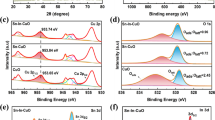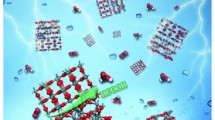Abstract
Sn-based electrocatalysts have recently been applied for CO2 reduction to generate fuels. Here, tin oxide crossed architectures (SnO) and petal-like Sn3O4 semiconductors were synthesized using the microwave-assisted hydrothermal method. The synthesized materials were applied in electrochemical reduction of CO2 and promoted the formation of methanol, ethanol and acetone. The best condition (greatest amount of products) was obtained with − 0.5 V vs Ag/AgCl for both electrocatalysts. For the first time, acetone formation was observed using both SnO and Sn3O4 materials. The SnO electrocatalyst exhibited the best electrochemical activity for CO2 reduction, ascribed to higher charge transfer corroborated by the higher current densities and lower resistance in the Nyquist diagram. Differences in methanol concentration obtained by the samples were ascribed to the different morphology and charge transfer over the films. The results showed that Sn-based electrocatalysts can be applied to generate important products, such as methanol and ethanol, aside from promoting acetone formation.
Graphical Abstract






Similar content being viewed by others
References
Chu S, Majumdar A (2012) Opportunities and challenges for a sustainable energy future. Nature 488:294–303. https://doi.org/10.1038/nature11475
Torquato LDM, Pastrian FAC, Perini JAL et al (2020) Relation between the nature of the surface facets and the reactivity of Cu2O nanostructures anchored on TiO2NT@PDA electrodes in the photoelectrocatalytic conversion of CO2 to methanol. Appl Catal B Environ 261:1–10. https://doi.org/10.1016/j.apcatb.2019.118221
Dresselhaus MS, Thomas IL (2001) Alternative energy technologies. Nature 414:332–337. https://doi.org/10.1038/35104599
Chakraborty R, K V, Pradhan M, Nayak AK, (2022) Recent advancement of biomass-derived porous carbon based materials for energy and environmental remediation applications. J Mater Chem A 10:6965–7005. https://doi.org/10.1039/D1TA10269A
Zhang X, Romeiro FC, Guo S-X et al (2019) Size controllable metal nanoparticles anchored on nitrogen doped carbon for electrocatalytic energy conversion. ChemElectroChem 6:1508–1513. https://doi.org/10.1002/celc.201801265
Lim CS, Sofer Z, Jankovský O et al (2015) Electrochemical properties of layered SnO and PbO for energy applications. RSC Adv 5:101949–101958. https://doi.org/10.1039/C5RA18776A
Gu J, Héroguel F, Luterbacher J, Hu X (2018) Densely packed, ultra small SnO nanoparticles for enhanced activity and selectivity in electrochemical CO2 reduction. Angew Chem Int Ed 57:2943–2947. https://doi.org/10.1002/anie.201713003
Bharath G, Hai A, Rambabu K et al (2022) Fabrication of Pd/MnFe2O4 bifunctional 2-D nanosheets to enhance the yield of HCOOH from CO2 cathodic reduction paired with anodic oxidation to CH3OH. Fuel 311:122619. https://doi.org/10.1016/j.fuel.2021.122619
Yu Y, Lee SJ, Theerthagiri J et al (2022) Architecting the AuPt alloys for hydrazine oxidation as an anolyte in fuel cell: Comparative analysis of hydrazine splitting and water splitting for energy-saving H2 generation. Appl Catal B Environ 316:121603. https://doi.org/10.1016/j.apcatb.2022.121603
Lee Y, Yu Y, Tanaya Das H et al (2023) Pulsed laser-driven green synthesis of trimetallic AuPtCu nanoalloys for formic acid electro-oxidation in acidic environment. Fuel 332:126164. https://doi.org/10.1016/j.fuel.2022.126164
Huda A, Suman PH, Torquato LDM et al (2019) Visible light-driven photoelectrocatalytic degradation of acid yellow 17 using Sn3O4 flower-like thin films supported on Ti substrate (Sn3O4/TiO2/Ti). J Photochem Photobiol A Chem 376:196–205. https://doi.org/10.1016/j.jphotochem.2019.01.039
An X, Li S, Yoshida A et al (2019) Bi-doped SnO nanosheets supported on Cu foam for electrochemical reduction of CO2 to HCOOH. ACS Appl Mater Interfaces 11:42114–42122. https://doi.org/10.1021/acsami.9b13270
He Y, Li D, Chen J et al (2014) Sn3O4: a novel heterovalent-tin photocatalyst with hierarchical 3D nanostructures under visible light. RSC Adv 4:1266–1269. https://doi.org/10.1039/C3RA45743E
Balgude SD, Sethi YA, Kale BB et al (2016) Nanostructured layered Sn3O4 for hydrogen production and dye degradation under sunlight. RSC Adv 6:95663–95669. https://doi.org/10.1039/C6RA20058C
Romeiro FC, Martins AS, Costa e Silva B et al (2022) Photoelectrochemical hydrogen generation at hybrid rGO-Sn3O4/SnO2 nanocomposite. J Appl Electrochem 52:1469–1480. https://doi.org/10.1007/s10800-022-01729-3
Yang H, Huang Y, Deng J et al (2019) Selective electrocatalytic CO2 reduction enabled by SnO2 nanoclusters. J Energy Chem 37:93–96. https://doi.org/10.1016/j.jechem.2018.12.004
Li Q, Fu J, Zhu W et al (2017) Tuning Sn-catalysis for electrochemical reduction of CO2 to CO via the core/shell Cu/SnO2 structure. J Am Chem Soc 139:4290–4293. https://doi.org/10.1021/jacs.7b00261
Liu H, Miao B, Chuai H et al (2022) Nanoporous tin oxides for efficient electrochemical CO2 reduction to formate. Green Chem Eng 3:138–145. https://doi.org/10.1016/j.gce.2021.11.001
Ko Y-J, Kim J-Y, Lee WH et al (2022) Exploring dopant effects in stannic oxide nanoparticles for CO2 electro-reduction to formate. Nat Commun 13:2205. https://doi.org/10.1038/s41467-022-29783-7
Torres JA, Da Silva GTST, de Freitas SF, Ribeiro C (2020) Experimental evidence of CO2 photoreduction activity of SnO2 nanoparticles. ChemPhysChem 21:2392–2396. https://doi.org/10.1002/cphc.202000786
Wu J, Bai X, Ren Z et al (2021) Multivalent Sn species synergistically favours the CO2-into-HCOOH conversion. Nano Res 14:1053–1060. https://doi.org/10.1007/s12274-020-3149-2
Kong XY, Tong T, Ng B-J et al (2020) Topotactic transformation of bismuth oxybromide into bismuth tungstate: bandgap modulation of single-crystalline {001}-faceted nanosheets for enhanced photocatalytic CO2 reduction. ACS Appl Mater Interfaces 12:26991–27000. https://doi.org/10.1021/acsami.9b15950
Ding J, Strelcov E, Bassiri-Gharb N (2018) Effects of microstructure on electrochemical reactivity and conductivity in nanostructured ceria thin films. J Am Ceram Soc 101:283–292. https://doi.org/10.1111/jace.15183
Zhang R, Wang Q, Zhang J et al (2018) Morphology modulation of SnO photocatalyst: from microplate to hierarchical architectures self-assembled with thickness controllable nanosheets. CrystEngComm 20:4651–4665. https://doi.org/10.1039/C8CE00687C
Chen Z, Gao M-R, Duan N et al (2020) Tuning adsorption strength of CO2 and its intermediates on tin oxide-based electrocatalyst for efficient CO2 reduction towards carbonaceous products. Appl Catal B Environ 277:119252. https://doi.org/10.1016/j.apcatb.2020.119252
Wang S, Wang J, Xin H (2017) Insights into electrochemical CO2 reduction on tin oxides from first-principles calculations. Green Energy Environ 2:168–171. https://doi.org/10.1016/j.gee.2017.02.005
Zhou G, Wu X, Liu L et al (2015) Facet-controlled synthesis and facet-dependent photocatalytic properties of SnO2 micropolyhedrons. Appl Surf Sci 349:798–804. https://doi.org/10.1016/j.apsusc.2015.05.069
Prajapati PK, Malik A, Nandal N et al (2022) Morphology controlled Fe and Ni-doped CeO2 nanorods as an excellent heterojunction photocatalyst for CO2 reduction. Appl Surf Sci 588:152912. https://doi.org/10.1016/j.apsusc.2022.152912
Chen J, Wang L (2022) Effects of the catalyst dynamic changes and influence of the reaction environment on the performance of electrochemical CO2 reduction. Adv Mater 34:2103900. https://doi.org/10.1002/adma.202103900
Yeon S, Lee SJ, Kim J et al (2022) Sustainable removal of nitrite waste to value-added ammonia on Cu@Cu2O core–shell nanostructures by pulsed laser technique. Environ Res 215:114154. https://doi.org/10.1016/j.envres.2022.114154
Geurts J, Rau S, Richter W, Schmitte FJ (1984) SnO films and their oxidation to SnO2: Raman scattering, IR reflectivity and X-ray diffraction studies. Thin Solid Films 121:217–225. https://doi.org/10.1016/0040-6090(84)90303-1
Zima T, Bataev I (2016) Morphology and phase transformations of tin oxide nanostructures synthesized by the hydrothermal method in the presence of dicarboxylic acids. J Solid State Chem 243:282–289. https://doi.org/10.1016/j.jssc.2016.09.005
Wang H, Wang Y, Xu J et al (2012) Polyvinylpyrrolidone-assisted ultrasonic synthesis of SnO nanosheets and their use as conformal templates for tin dioxide nanostructures. Langmuir 28:10597–10601. https://doi.org/10.1021/la301827p
Cui Y, Wang F, Iqbal MZ et al (2015) Synthesis of nanoflakes-based self-assembling crossed structure of stannous oxide and photocatalysis property. Cryst Res Technol 50:210–214. https://doi.org/10.1002/crat.201400202
Zhang J, Han Y, Liu C et al (2011) Electrical transport properties of SnO under high pressure. J Phys Chem C 115:20710–20715. https://doi.org/10.1021/jp206245m
Saji KJ, Venkata Subbaiah YP, Tian K, Tiwari A (2016) P-type SnO thin films and SnO/ZnO heterostructures for all-oxide electronic and optoelectronic device applications. Thin Solid Films 605:193–201. https://doi.org/10.1016/j.tsf.2015.09.026
Jia J, Sugane T, Nakamura S, Shigesato Y (2020) p-type conduction mechanism in continuously varied non-stoichimetric SnOx thin films deposited by reactive sputtering with the impedance control. J Appl Phys 127:185703. https://doi.org/10.1063/5.0005953
Minohara M, Kikuchi N, Yoshida Y et al (2019) Improvement of the hole mobility of SnO epitaxial films grown by pulsed laser deposition. J Mater Chem C 7:6332–6336. https://doi.org/10.1039/C9TC01297D
Yang R, Liang N, Chen X et al (2021) Sn/Sn3O4−x heterostructure rich in oxygen vacancies with enhanced visible light photocatalytic oxidation performance. Int J Miner Metall Mater 28:150–159. https://doi.org/10.1007/s12613-020-2131-z
Thiyagarajan K, Sivakumar K (2017) Oxygen vacancy-induced room temperature ferromagnetism in graphene–SnO2 nanocomposites. J Mater Sci 52:8084–8096. https://doi.org/10.1007/s10853-017-1016-7
Lu YC, Ma C, Alvarado J et al (2015) Electrochemical properties of tin oxide anodes for sodium-ion batteries. J Power Sour 284:287–295. https://doi.org/10.1016/j.jpowsour.2015.03.042
Nayak AK, Gopalakrishnan T (2022) Phase- and crystal structure-controlled synthesis of Bi2O3, Fe2O3, and BiFeO3 nanomaterials for energy storage devices. ACS Appl Nano Mater 5:14663–14676. https://doi.org/10.1021/acsanm.2c03026
Romeiro FC, Silva BC, Martins AS et al (2021) Superior performance of rGO-tin oxide nanocomposite for selective reduction of CO2 to methanol. J CO2 Util 46:101460. https://doi.org/10.1016/j.jcou.2021.101460
Um J, Roh B-M, Kim S, Eunkyung Kim S (2013) Effect of radio frequency power on the properties of p-type SnO deposited via sputtering. Mater Sci Semicond Process 16:1679–1683. https://doi.org/10.1016/j.mssp.2013.03.009
Liu L, Wang S, Huang H et al (2020) Surface sites engineering on semiconductors to boost photocatalytic CO2 reduction. Nano Energy 75:104959. https://doi.org/10.1016/j.nanoen.2020.104959
Han Q, Bai X, Man Z et al (2019) Convincing synthesis of atomically thin, single-crystalline InVO4 sheets toward promoting highly selective and efficient solar conversion of CO2 into CO. J Am Chem Soc 141:4209–4213. https://doi.org/10.1021/jacs.8b13673
Wang Z, Nayak PK, Caraveo-Frescas JA, Alshareef HN (2016) Recent developments in p-type oxide semiconductor materials and devices. Adv Mater 28:3831–3892. https://doi.org/10.1002/adma.201503080
Corradini PG, de Brito JF, Boldrin Zanoni MV, Mascaro LH (2020) Artificial photosynthesis for alcohol and 3-C compound formation using BiVO4-lamelar catalyst. J CO2 Util 36:187–195. https://doi.org/10.1016/j.jcou.2019.10.020
Zhao Y, Wang H, Han J et al (2018) Active site ensembles enabled C–C coupling of CO2 and CH4 for acetone production. J Phys Chem C 122:9570–9577. https://doi.org/10.1021/acs.jpcc.8b02359
de Brito JF, Hudari FF, Zanoni MVB (2018) Photoelectrocatalytic performance of nanostructured p–n junction NtTiO2/NsCuO electrode in the selective conversion of CO2 to methanol at low bias potentials. J CO2 Util 24:81–88. https://doi.org/10.1016/j.jcou.2017.12.008
Chang X, Wang T, Gong J (2016) CO2 photo-reduction: insights into CO2 activation and reaction on surfaces of photocatalysts. Energy Environ Sci 9:2177–2196. https://doi.org/10.1039/C6EE00383D
Xu X, Ge M, Ståhl K, Jiang JZ (2009) Growth mechanism of cross-like SnO structure synthesized by thermal decomposition. Chem Phys Lett 482:287–290. https://doi.org/10.1016/j.cplett.2009.10.012
de Brito JF, Andrade MAS, Zanoni MVB, Mascaro LH (2022) All-solution processed CuGaS2-based photoelectrodes for CO2 reduction. J CO2 Util 57:101902. https://doi.org/10.1016/j.jcou.2022.101902
Acknowledgements
The authors acknowledge the São Paulo State Research Foundation (FAPESP) (Procs. 2019/18856-5, 2017/26219-0, 2017/13123-4, 2016/18057-7) for financial support. The authors are grateful to the National Council for Scientific and Technological Development (CNPq) (Processes 154509/2018-3, 150223/2019-6), INCT-DATREN (FAPESP-2014/50945-4; CNPq- 465571/2014-0) and also to the support from FINEP 2018 (Proc. 0382/16). The authors thank for the XPS measurements, Procs. FAPESP 2013/07296-2. FEG-SEM facilities were provided by the IQ-UNESP.
Author information
Authors and Affiliations
Contributions
Fernanda da Costa Romeiro was involved in conceptualization, investigation, methodology and writing—reviewing and editing. Alysson Stefan Martins was responsible for writing—reviewing and methodology. João Angelo Perini took part in methodology, investigation and writing—reviewing. Beatriz Costa e Silva participated in investigation and methodology. Maria Valnice Boldrin Zanoni and Marcelo Ornaghi Orlandi contributed to resources, project administration, writing—reviewing and supervision.
Corresponding authors
Ethics declarations
Conflict of interest
The authors declare that they have no known competing financial interests or personal relationships that could have appeared to influence the work reported in this paper.
Additional information
Handling Editor: David Cann.
Publisher's Note
Springer Nature remains neutral with regard to jurisdictional claims in published maps and institutional affiliations.
Supplementary Information
Below is the link to the electronic supplementary material.
Rights and permissions
Springer Nature or its licensor (e.g. a society or other partner) holds exclusive rights to this article under a publishing agreement with the author(s) or other rightsholder(s); author self-archiving of the accepted manuscript version of this article is solely governed by the terms of such publishing agreement and applicable law.
About this article
Cite this article
Romeiro, F.d., Martins, A.S., Perini, J.A.L. et al. Microwave-assisted hydrothermal synthesis of Sn3O4 and SnO for electrocatalytic reduction of CO2 to high-added-value compounds. J Mater Sci 58, 3508–3519 (2023). https://doi.org/10.1007/s10853-023-08230-y
Received:
Accepted:
Published:
Issue Date:
DOI: https://doi.org/10.1007/s10853-023-08230-y




